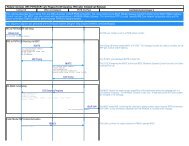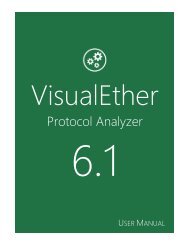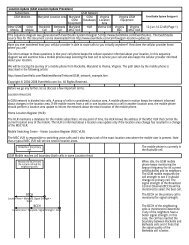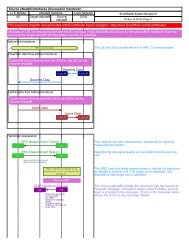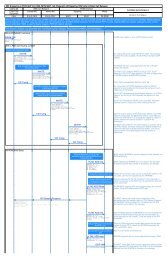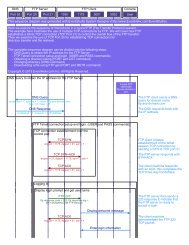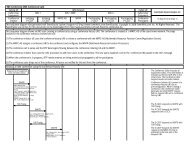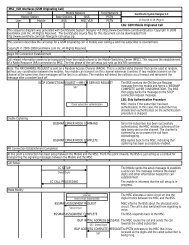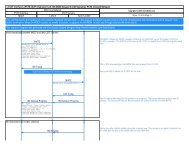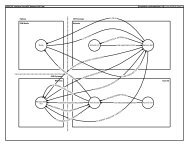SIP Tutorial: SIP to PSTN Call Flow (Detailed) - EventHelix.com
SIP Tutorial: SIP to PSTN Call Flow (Detailed) - EventHelix.com
SIP Tutorial: SIP to PSTN Call Flow (Detailed) - EventHelix.com
You also want an ePaper? Increase the reach of your titles
YUMPU automatically turns print PDFs into web optimized ePapers that Google loves.
Session Initiation Pro<strong>to</strong>col (<strong>SIP</strong> <strong>Tu<strong>to</strong>rial</strong>: <strong>SIP</strong> <strong>to</strong> <strong>PSTN</strong> <strong>Call</strong> <strong>Flow</strong>)<br />
<strong>SIP</strong><br />
Network<br />
Subscriber<br />
<strong>SIP</strong> Client VOIP Network <strong>PSTN</strong> Network<br />
Alice Proxy 1 NGW 1 Switch<br />
<strong>EventHelix</strong>.<strong>com</strong>/EventStudio 2.5<br />
10-Jun-05 22:33 (Page 1)<br />
This call flow diagram was generated with EventStudio Sequence Diagram Designer 2.5 (http://www.<strong>EventHelix</strong>.<strong>com</strong>/EventStudio).<br />
LEG: Brief<br />
This article is based on the call flow presented in<br />
http://www.iptel.org/info/players/ietf/callflows/draft-ietf-sipping-pstn-call-flows-02.txt<br />
and is reproduced here as per the copyright statement at the end of this document.<br />
In this scenario, Alice (sip:alice@a.example.<strong>com</strong>) is a <strong>SIP</strong> phone or other <strong>SIP</strong>-enabled device. Bob is reachable via the <strong>PSTN</strong> at global<br />
telephone number +19725552222. Alice places a call <strong>to</strong> Bob through a Proxy Server (Proxy 1) and a Network Gateway (NGW 1).<br />
Bob answers the call then Alice disconnects the call. Signaling between NGW 1 and Bob's telephone switch is ANSI ISUP.<br />
<strong>SIP</strong> INVITE<br />
<strong>Call</strong>ing = +13145551111,<br />
<strong>Call</strong>ed = +19725552222,<br />
Contact =<br />
alice@client.a.example.<strong>com</strong>,<br />
Media = audio 49172<br />
RTP/AVP,<br />
Attribute = rtpmap:0<br />
PCMU/8000<br />
<strong>SIP</strong> 100 Trying<br />
Open port 49172 for RTP<br />
receive<br />
Locate the <strong>SIP</strong> <strong>PSTN</strong> Gateway <strong>to</strong><br />
route this call<br />
<strong>SIP</strong> INVITE<br />
<strong>Call</strong>ing = +13145551111,<br />
<strong>Call</strong>ed = +19725552222,<br />
Contact =<br />
alice@client.a.example.<strong>com</strong>,<br />
Media = audio 49172<br />
RTP/AVP,<br />
Attribute = rtpmap:0<br />
PCMU/8000<br />
<strong>SIP</strong> 100 Trying<br />
<strong>SIP</strong> 183 Session Progress<br />
Contact =<br />
ngw1@a.example.<strong>com</strong>,<br />
media = audio 3456<br />
RTP/AVP 0,<br />
attribute = rtpmap:0<br />
PCMU/8000<br />
ISUP IAM<br />
<strong>Call</strong>ing Number =<br />
314-555-1111,<br />
<strong>Call</strong>ed Number =<br />
972-555-2222,<br />
NPI = E.164,<br />
NOA = National<br />
ACM<br />
Switch one-way voice<br />
<strong>to</strong>wards originating<br />
subscriber<br />
Ringing Tone<br />
Alice dials the globalized E.164 number +19725552222 <strong>to</strong> reach Bob. Note that A<br />
might have only dialed the last 7 digits, or some other dialing plan. It is assumed<br />
that the <strong>SIP</strong> User Agent Client converts the digits in<strong>to</strong> a global number and puts<br />
them in<strong>to</strong> a <strong>SIP</strong> URI. Note that tel URIs could be used instead of <strong>SIP</strong> URIs.<br />
Proxy 1 indicates <strong>to</strong> the <strong>SIP</strong> client that it is trying <strong>to</strong> establish the call.<br />
Client for A prepares <strong>to</strong> receive data on port 49172 from the network.<br />
Proxy 1 uses a Location Service function <strong>to</strong> determine the gateway for terminating<br />
this call. The location service returns NGW 1 as the gateway.<br />
The call is forwarded <strong>to</strong> the <strong>PSTN</strong> Network Gateway NGW 1. The <strong>SIP</strong> INVITE<br />
message is sent <strong>to</strong> NGW 1.<br />
NGW 1 indicates <strong>to</strong> the proxy that it is trying <strong>to</strong> establish the call.<br />
<strong>SIP</strong> <strong>PSTN</strong> Gateway sends ISUP Initial Address Message <strong>to</strong> the <strong>PSTN</strong>. The calling<br />
and the called numbers are included in the message.<br />
Since all the digits were included in the ISUP IAM, the switch replies with ISUP<br />
Address Complete message. This signals that the switch has received all the<br />
digits and is processing the call.<br />
The switch connects a one way voice path <strong>to</strong>wards Alice. This is needed <strong>to</strong> send<br />
the ringing <strong>to</strong>ne.<br />
The switch sends the ringing <strong>to</strong>ne <strong>to</strong> the subscriber.<br />
A <strong>SIP</strong> Session in Progess message is generated when the NGW 1 receives the<br />
ACM message from the switch. The "Session Progress" message also contains<br />
RTP media information for the RTP port allocated for this call.<br />
Open port 3456 for RTP receive<br />
Ringing Tone<br />
Start sending received <strong>PSTN</strong><br />
Audio via RTP<br />
<strong>SIP</strong> <strong>PSTN</strong> Gateway sends <strong>PSTN</strong> audio (ringing) in the RTP path <strong>to</strong> A
Session Initiation Pro<strong>to</strong>col (<strong>SIP</strong> <strong>Tu<strong>to</strong>rial</strong>: <strong>SIP</strong> <strong>to</strong> <strong>PSTN</strong> <strong>Call</strong> <strong>Flow</strong>)<br />
<strong>SIP</strong><br />
Network<br />
Subscriber<br />
<strong>SIP</strong> Client VOIP Network <strong>PSTN</strong> Network<br />
Alice Proxy 1 NGW 1 Switch<br />
<strong>SIP</strong> 183 Session Progress<br />
Contact =<br />
ngw1@a.example.<strong>com</strong>,<br />
media = audio 3456<br />
RTP/AVP 0,<br />
attribute = rtpmap:0<br />
PCMU/8000<br />
<strong>EventHelix</strong>.<strong>com</strong>/EventStudio 2.5<br />
10-Jun-05 22:33 (Page 2)<br />
At this point, a bi-directional RTP voice path has been established between Alice and NGW 1. The Switch <strong>to</strong> NGW 1<br />
is a uni-directional voice path. Alice is hearing the ringing <strong>to</strong>ne from the switch.<br />
<strong>SIP</strong> 200 OK<br />
<strong>SIP</strong> ACK<br />
<strong>SIP</strong> 200 OK<br />
Contact =<br />
ngw1@a.example.<strong>com</strong>,<br />
media = audio 3456<br />
RTP/AVP 0,<br />
attribute = rtpmap:0<br />
PCMU/8000<br />
<strong>SIP</strong> ACK<br />
Switch through bidirectional<br />
voice<br />
ISUP ANM Bob answers the call. The switch sends an ISUP Answer message <strong>to</strong> NGW 1.<br />
Switch a bidirectional<br />
voice path<br />
A bi-directional voice path is switched between the calling and the called<br />
subscriber.<br />
NGW 1 responds with <strong>SIP</strong> OK message <strong>to</strong> Proxy 1 <strong>to</strong> indicate that the subscriber<br />
has answered the call.<br />
Proxy 1 sends <strong>SIP</strong> OK message <strong>to</strong> Alice's <strong>SIP</strong> client.<br />
The <strong>SIP</strong> client acknowledges the receipt of <strong>SIP</strong> OK message.<br />
Proxy 1 acknowledges the receipt of <strong>SIP</strong> OK message.<br />
At this point, NGW 1 bridges the bidirectional RTP path and the bidirectional <strong>SIP</strong><br />
path.<br />
Voice <strong>com</strong>munciation between Alice and Bob as the RTP (AliceNGW 1) and <strong>PSTN</strong> (NGW 1Switch) paths are bidirectional.<br />
Alice Hangs Up with Bob.<br />
<strong>SIP</strong> BYE The <strong>SIP</strong> client sends a BYE message <strong>to</strong> Proxy 1<br />
<strong>SIP</strong> 200 OK<br />
Close port 49172<br />
<strong>SIP</strong> BYE<br />
<strong>SIP</strong> 200 OK<br />
Close RTP port 3456<br />
ISUP REL<br />
ISUP RLC<br />
Proxy 1 sends a BYE indicatation <strong>to</strong> the Network Gateway.<br />
NGW 1 replies back with success, acknowledging the receipt of call release<br />
request.<br />
NGW 1 releases the RTP port that was being used for <strong>com</strong>munciation with Alice's<br />
<strong>SIP</strong> client.<br />
NGW 1 signals the call release <strong>to</strong> the switch via an ISUP Release message.<br />
In the meanwhile, Proxy 1 acknowleges the BYE message <strong>to</strong> the <strong>SIP</strong> client.<br />
Voice <strong>com</strong>munciation is over, so the RTP port can be closed.<br />
The Switch releases the voice call and replies with ISUP Release Complete<br />
message.
Session Initiation Pro<strong>to</strong>col (<strong>SIP</strong> <strong>Tu<strong>to</strong>rial</strong>: <strong>SIP</strong> <strong>to</strong> <strong>PSTN</strong> <strong>Call</strong> <strong>Flow</strong> (<strong>Detailed</strong>))<br />
<strong>SIP</strong><br />
Network<br />
Subscriber<br />
<strong>SIP</strong> Client VOIP Network <strong>PSTN</strong> Network<br />
Alice Proxy 1 NGW 1 Switch<br />
<strong>EventHelix</strong>.<strong>com</strong>/EventStudio 2.5<br />
10-Jun-05 22:33 (Page 3)<br />
This call flow diagram was generated with EventStudio Sequence Diagram Designer 2.5 (http://www.<strong>EventHelix</strong>.<strong>com</strong>/EventStudio).<br />
LEG: <strong>Detailed</strong><br />
In this scenario, Alice (sip:alice@a.example.<strong>com</strong>) is a <strong>SIP</strong> phone or other <strong>SIP</strong>-enabled device. Bob is reachable via the <strong>PSTN</strong> at global<br />
telephone number +19725552222. Alice places a call <strong>to</strong> Bob through a Proxy Server (Proxy 1) and a Network Gateway (NGW 1).<br />
Bob answers the call then Alice disconnects the call. Signaling between NGW 1 and Bob's telephone switch is ANSI ISUP.<br />
<strong>SIP</strong> INVITE<br />
<strong>Call</strong>ing = +13145551111,<br />
<strong>Call</strong>ed = +19725552222,<br />
Contact =<br />
alice@client.a.example.<strong>com</strong>,<br />
Media = audio 49172<br />
RTP/AVP,<br />
Attribute = rtpmap:0<br />
PCMU/8000<br />
INVITE sip:+19725552222@ss1.a.example.<strong>com</strong>;user=phone <strong>SIP</strong>/2.0<br />
Via: <strong>SIP</strong>/2.0/TCP client.a.example.<strong>com</strong>:5060;branch=z9hG4bK74bf9<br />
Max-Forwards: 70<br />
From: Alice ;tag=9fxced76sl<br />
To: Bob <br />
<strong>Call</strong>-ID: 2xTb9vxSit55XU7p8@a.example.<strong>com</strong><br />
CSeq: 1 INVITE<br />
Contact: <br />
Proxy-Authorization: Digest username="alice", realm="a.example.<strong>com</strong>",<br />
nonce="dc3a5ab25302aa931904ba7d88fa1cf5", opaque="",<br />
uri="sip:+19725552222@ss1.a.example.<strong>com</strong>;user=phone",<br />
response="ccdca50cb091d587421457305d097458c"<br />
Content-Type: application/sdp<br />
Content-Length: 154<br />
v=0<br />
o=alice 2890844526 2890844526 IN IP4 client.a.example.<strong>com</strong><br />
s=c=IN<br />
IP4 client.a.example.<strong>com</strong><br />
t=0 0<br />
m=audio 49172 RTP/AVP 0<br />
a=rtpmap:0 PCMU/8000<br />
<strong>SIP</strong> 100 Trying<br />
<strong>SIP</strong>/2.0 100 Trying<br />
Via: <strong>SIP</strong>/2.0/TCP client.a.example.<strong>com</strong>:5060;branch=z9hG4bK74bf9;received=192.0.2.101<br />
From: Alice ;tag=9fxced76sl<br />
To: Bob <br />
<strong>Call</strong>-ID: 2xTb9vxSit55XU7p8@a.example.<strong>com</strong><br />
CSeq: 1 INVITE<br />
Content-Length: 0<br />
Alice dials the globalized E.164 number +19725552222 <strong>to</strong> reach Bob. Note that A<br />
might have only dialed the last 7 digits, or some other dialing plan. It is assumed<br />
that the <strong>SIP</strong> User Agent Client converts the digits in<strong>to</strong> a global number and puts<br />
them in<strong>to</strong> a <strong>SIP</strong> URI. Note that tel URIs could be used instead of <strong>SIP</strong> URIs.<br />
Alice could use either their <strong>SIP</strong> address (sip:alice@a.example.<strong>com</strong>) or <strong>SIP</strong><br />
telephone number (sip:+13145551111@ss1.a.example.<strong>com</strong>;user=phone) in the<br />
From header. In this example, the telephone number is included, and it is shown<br />
as being passed as calling party identification through the Network Gateway<br />
(NGW 1) <strong>to</strong> Bob. Note that for this number <strong>to</strong> be passed in<strong>to</strong> the SS7 network, it<br />
would have <strong>to</strong> be somehow verified for accuracy.<br />
Proxy 1 indicates <strong>to</strong> the <strong>SIP</strong> client that it is trying <strong>to</strong> establish the call.<br />
Open port 49172 for RTP<br />
receive<br />
Locate the <strong>SIP</strong> <strong>PSTN</strong> Gateway <strong>to</strong><br />
route this call<br />
<strong>SIP</strong> INVITE<br />
<strong>Call</strong>ing = +13145551111,<br />
<strong>Call</strong>ed = +19725552222,<br />
Contact =<br />
alice@client.a.example.<strong>com</strong>,<br />
Media = audio 49172<br />
RTP/AVP,<br />
Attribute = rtpmap:0<br />
PCMU/8000<br />
Client for A prepares <strong>to</strong> receive data on port 49172 from the network.<br />
Proxy 1 uses a Location Service function <strong>to</strong> determine the gateway for terminating<br />
this call. The location service returns NGW 1 as the gateway.<br />
The call is forwarded <strong>to</strong> the <strong>PSTN</strong> Network Gateway NGW 1. The <strong>SIP</strong> INVITE<br />
message is sent <strong>to</strong> NGW 1.<br />
INVITE sip:+19725552222@ngw1.a.example.<strong>com</strong>;user=phone <strong>SIP</strong>/2.0<br />
Via: <strong>SIP</strong>/2.0/TCP ss1.a.example.<strong>com</strong>:5060;branch=z9hG4bK2d4790.1<br />
Via: <strong>SIP</strong>/2.0/TCP client.a.example.<strong>com</strong>:5060;branch=z9hG4bK74bf9;received=192.0.2.101<br />
Max-Forwards: 69<br />
Record-Route: <br />
From: Alice ;tag=9fxced76sl<br />
To: Bob <br />
<strong>Call</strong>-ID: 2xTb9vxSit55XU7p8@a.example.<strong>com</strong><br />
CSeq: 1 INVITE<br />
Contact: <br />
Content-Type: application/sdp<br />
Content-Length: 154<br />
v=0<br />
o=alice 2890844526 2890844526 IN IP4 client.a.example.<strong>com</strong>
Session Initiation Pro<strong>to</strong>col (<strong>SIP</strong> <strong>Tu<strong>to</strong>rial</strong>: <strong>SIP</strong> <strong>to</strong> <strong>PSTN</strong> <strong>Call</strong> <strong>Flow</strong> (<strong>Detailed</strong>))<br />
<strong>SIP</strong><br />
Network<br />
Subscriber<br />
<strong>SIP</strong> Client VOIP Network <strong>PSTN</strong> Network<br />
Alice Proxy 1 NGW 1 Switch<br />
<strong>EventHelix</strong>.<strong>com</strong>/EventStudio 2.5<br />
10-Jun-05 22:33 (Page 4)<br />
s=c=IN<br />
IP4 client.a.example.<strong>com</strong><br />
t=0 0<br />
m=audio 49172 RTP/AVP 0<br />
a=rtpmap:0 PCMU/8000<br />
<strong>SIP</strong> 100 Trying<br />
<strong>SIP</strong>/2.0 100 Trying<br />
Via: <strong>SIP</strong>/2.0/TCP ss1.a.example.<strong>com</strong>:5060;branch=z9hG4bK2d4790.1;received=192.0.2.111<br />
From: Alice ;tag=9fxced76sl<br />
To: Bob <br />
<strong>Call</strong>-ID: 2xTb9vxSit55XU7p8@a.example.<strong>com</strong><br />
CSeq: 1 INVITE<br />
Content-Length: 0<br />
NGW 1 indicates <strong>to</strong> the proxy that it is trying <strong>to</strong> establish the call.<br />
ISUP IAM<br />
<strong>Call</strong>ing Number =<br />
314-555-1111,<br />
<strong>Call</strong>ed Number =<br />
972-555-2222,<br />
NPI = E.164,<br />
NOA = National<br />
<strong>SIP</strong> <strong>PSTN</strong> Gateway sends ISUP Initial Address Message <strong>to</strong> the <strong>PSTN</strong>. The calling<br />
and the called numbers are included in the message.<br />
<strong>SIP</strong> 183 Session Progress<br />
Contact =<br />
ngw1@a.example.<strong>com</strong>,<br />
media = audio 3456<br />
RTP/AVP 0,<br />
attribute = rtpmap:0<br />
PCMU/8000<br />
ACM<br />
Switch one-way voice<br />
<strong>to</strong>wards originating<br />
subscriber<br />
Ringing Tone<br />
Since all the digits were included in the ISUP IAM, the switch replies with ISUP<br />
Address Complete message. This signals that the switch has received all the<br />
digits and is processing the call.<br />
The switch connects a one way voice path <strong>to</strong>wards Alice. This is needed <strong>to</strong> send<br />
the ringing <strong>to</strong>ne.<br />
The switch sends the ringing <strong>to</strong>ne <strong>to</strong> the subscriber.<br />
<strong>SIP</strong>/2.0 183 Session Progress<br />
Via: <strong>SIP</strong>/2.0/TCP ss1.a.example.<strong>com</strong>:5060;branch=z9hG4bK2d4790.1;received=192.0.2.111<br />
Via: <strong>SIP</strong>/2.0/TCP client.a.example.<strong>com</strong>:5060;branch=z9hG4bK74bf9;received=192.0.2.101<br />
Record-Route: <br />
From: Alice ;tag=9fxced76sl<br />
To: Bob ;tag=314159<br />
<strong>Call</strong>-ID: 2xTb9vxSit55XU7p8@a.example.<strong>com</strong><br />
CSeq: 1 INVITE<br />
Contact: <br />
Content-Type: application/sdp<br />
Content-Length: 146<br />
v=0<br />
o=GW 2890844527 2890844527 IN IP4 ngw1.a.example.<strong>com</strong><br />
s=c=IN<br />
IP4 ngw1.a.example.<strong>com</strong><br />
t=0 0<br />
m=audio 3456 RTP/AVP 0<br />
a=rtpmap:0 PCMU/8000<br />
Open port 3456 for RTP receive<br />
A <strong>SIP</strong> Session in Progess message is generated when the NGW 1 receives the<br />
ACM message from the switch. The "Session Progress" message also contains<br />
RTP media information for the RTP port allocated for this call.<br />
Notice that the Contact returned by NGW 1 in this and following messages is<br />
sip:ngw1@a.example.<strong>com</strong>. This is because NGW 1 only accepts <strong>SIP</strong> messages<br />
that <strong>com</strong>e through Proxy 1 - any direct signaling will be ignored. Since this<br />
Contact URI may be used outside of this dialog and must be routable (Section<br />
8.1.1.8 in RFC 3261 [2]) the Contact URI for NGW 1 must resolve <strong>to</strong> Proxy 1. This<br />
Contact URI is an AOR which resolves via DNS <strong>to</strong> Proxy 1<br />
(sip:ss1.a.example.<strong>com</strong>) which then resolves it <strong>to</strong> sip:ngw1.a.example.<strong>com</strong> which<br />
is the address of NGW 1.<br />
Ringing Tone<br />
<strong>SIP</strong> 183 Session Progress<br />
Contact =<br />
ngw1@a.example.<strong>com</strong>,<br />
media = audio 3456<br />
RTP/AVP 0,<br />
attribute = rtpmap:0<br />
PCMU/8000<br />
Start sending received <strong>PSTN</strong><br />
Audio via RTP<br />
<strong>SIP</strong> <strong>PSTN</strong> Gateway sends <strong>PSTN</strong> audio (ringing) in the RTP path <strong>to</strong> A
Session Initiation Pro<strong>to</strong>col (<strong>SIP</strong> <strong>Tu<strong>to</strong>rial</strong>: <strong>SIP</strong> <strong>to</strong> <strong>PSTN</strong> <strong>Call</strong> <strong>Flow</strong> (<strong>Detailed</strong>))<br />
<strong>SIP</strong><br />
Network<br />
Subscriber<br />
<strong>SIP</strong> Client VOIP Network <strong>PSTN</strong> Network<br />
Alice Proxy 1 NGW 1 Switch<br />
<strong>EventHelix</strong>.<strong>com</strong>/EventStudio 2.5<br />
10-Jun-05 22:33 (Page 5)<br />
<strong>SIP</strong>/2.0 183 Session Progress<br />
Via: <strong>SIP</strong>/2.0/TCP client.a.example.<strong>com</strong>:5060;branch=z9hG4bK74bf9;received=192.0.2.101<br />
Record-Route: <br />
From: Alice ;tag=9fxced76sl<br />
To: Bob ;tag=314159<br />
<strong>Call</strong>-ID: 2xTb9vxSit55XU7p8@a.example.<strong>com</strong><br />
CSeq: 1 INVITE<br />
Contact: <br />
Content-Type: application/sdp<br />
Content-Length: 146<br />
v=0<br />
o=GW 2890844527 2890844527 IN IP4 ngw1.a.example.<strong>com</strong><br />
s=c=IN<br />
IP4 ngw1.a.example.<strong>com</strong><br />
t=0 0<br />
m=audio 3456 RTP/AVP 0<br />
a=rtpmap:0 PCMU/8000<br />
At this point, a bi-directional RTP voice path has been established between Alice and NGW 1. The Switch <strong>to</strong> NGW 1<br />
is a uni-directional voice path. Alice is hearing the ringing <strong>to</strong>ne from the switch.<br />
<strong>SIP</strong> 200 OK<br />
Contact =<br />
ngw1@a.example.<strong>com</strong>,<br />
media = audio 3456<br />
RTP/AVP 0,<br />
attribute = rtpmap:0<br />
PCMU/8000<br />
ISUP ANM Bob answers the call. The switch sends an ISUP Answer message <strong>to</strong> NGW 1.<br />
Switch a bidirectional<br />
voice path<br />
A bi-directional voice path is switched between the calling and the called<br />
subscriber.<br />
NGW 1 responds with <strong>SIP</strong> OK message <strong>to</strong> Proxy 1 <strong>to</strong> indicate that the subscriber<br />
has answered the call.<br />
<strong>SIP</strong>/2.0 200 OK<br />
Via: <strong>SIP</strong>/2.0/TCP ss1.a.example.<strong>com</strong>:5060;branch=z9hG4bK2d4790.1;received=192.0.2.111<br />
Via: <strong>SIP</strong>/2.0/TCP client.a.example.<strong>com</strong>:5060;branch=z9hG4bK74bf9;received=192.0.2.101<br />
Record-Route: <br />
From: Alice ;tag=9fxced76sl<br />
To: Bob ;tag=314159<br />
<strong>Call</strong>-ID: 2xTb9vxSit55XU7p8@a.example.<strong>com</strong><br />
CSeq: 1 INVITE<br />
Contact: <br />
Content-Type: application/sdp<br />
Content-Length: 146<br />
v=0<br />
o=GW 2890844527 2890844527 IN IP4 ngw1.a.example.<strong>com</strong><br />
s=c=IN<br />
IP4 gw1.a.example.<strong>com</strong><br />
t=0 0<br />
m=audio 3456 RTP/AVP 0<br />
a=rtpmap:0 PCMU/8000<br />
<strong>SIP</strong> 200 OK<br />
Proxy 1 sends <strong>SIP</strong> OK message <strong>to</strong> Alice's <strong>SIP</strong> client.<br />
<strong>SIP</strong>/2.0 200 OK<br />
Via: <strong>SIP</strong>/2.0/TCP client.a.example.<strong>com</strong>:5060;branch=z9hG4bK74bf9;received=192.0.2.101<br />
Record-Route: <br />
From: Alice ;tag=9fxced76sl<br />
To: Bob ;tag=314159<br />
<strong>Call</strong>-ID: 2xTb9vxSit55XU7p8@a.example.<strong>com</strong><br />
CSeq: 1 INVITE<br />
Contact: <br />
Content-Type: application/sdp<br />
Content-Length: 146<br />
v=0<br />
o=GW 2890844527 2890844527 IN IP4 ngw1.a.example.<strong>com</strong><br />
s=c=IN<br />
IP4 ngw1.a.example.<strong>com</strong><br />
t=0 0<br />
m=audio 3456 RTP/AVP 0<br />
a=rtpmap:0 PCMU/8000<br />
<strong>SIP</strong> ACK<br />
ACK sip:ngw1@a.example.<strong>com</strong> <strong>SIP</strong>/2.0<br />
Via: <strong>SIP</strong>/2.0/TCP client.a.example.<strong>com</strong>:5060;branch=z9hG4bK74bf9<br />
Max-Forwards: 70<br />
Route: <br />
From: Alice ;tag=9fxced76sl<br />
To: Bob ;tag=314159<br />
<strong>Call</strong>-ID: 2xTb9vxSit55XU7p8@a.example.<strong>com</strong><br />
CSeq: 1 ACK<br />
Content-Length: 0<br />
The <strong>SIP</strong> client acknowledges the receipt of <strong>SIP</strong> OK message.
Session Initiation Pro<strong>to</strong>col (<strong>SIP</strong> <strong>Tu<strong>to</strong>rial</strong>: <strong>SIP</strong> <strong>to</strong> <strong>PSTN</strong> <strong>Call</strong> <strong>Flow</strong> (<strong>Detailed</strong>))<br />
<strong>SIP</strong><br />
Network<br />
Subscriber<br />
<strong>SIP</strong> Client VOIP Network <strong>PSTN</strong> Network<br />
Alice Proxy 1 NGW 1 Switch<br />
<strong>EventHelix</strong>.<strong>com</strong>/EventStudio 2.5<br />
10-Jun-05 22:33 (Page 6)<br />
<strong>SIP</strong> ACK<br />
Proxy 1 acknowledges the receipt of <strong>SIP</strong> OK message.<br />
ACK sip:ngw1@a.example.<strong>com</strong> <strong>SIP</strong>/2.0<br />
Via: <strong>SIP</strong>/2.0/TCP ss1.a.example.<strong>com</strong>:5060;branch=z9hG4bK2d4790.1<br />
Via: <strong>SIP</strong>/2.0/TCP client.a.example.<strong>com</strong>:5060;branch=z9hG4bK74bf9;received=192.0.2.101<br />
Max-Forwards: 69<br />
From: Alice ;tag=9fxced76sl<br />
To: Bob ;tag=314159<br />
<strong>Call</strong>-ID: 2xTb9vxSit55XU7p8@a.example.<strong>com</strong><br />
CSeq: 1 ACK<br />
Content-Length: 0<br />
Switch through bidirectional<br />
voice<br />
At this point, NGW 1 bridges the bidirectional RTP path and the bidirectional <strong>SIP</strong><br />
path.<br />
Voice <strong>com</strong>munciation between Alice and Bob as the RTP (AliceNGW 1) and <strong>PSTN</strong> (NGW 1Switch) paths are bidirectional.<br />
Alice Hangs Up with Bob.<br />
<strong>SIP</strong> BYE The <strong>SIP</strong> client sends a BYE message <strong>to</strong> Proxy 1<br />
BYE sip:ngw1@a.example.<strong>com</strong> <strong>SIP</strong>/2.0<br />
Via: <strong>SIP</strong>/2.0/TCP client.a.example.<strong>com</strong>:5060;branch=z9hG4bK74bf9<br />
Max-Forwards: 70<br />
Route: <br />
From: Alice ;tag=9fxced76sl<br />
To: Bob ;tag=314159<br />
<strong>Call</strong>-ID: 2xTb9vxSit55XU7p8@a.example.<strong>com</strong><br />
CSeq: 2 BYE<br />
Content-Length: 0<br />
<strong>SIP</strong> BYE<br />
BYE sip:ngw1@a.example.<strong>com</strong> <strong>SIP</strong>/2.0<br />
Via: <strong>SIP</strong>/2.0/TCP ss1.a.example.<strong>com</strong>:5060;branch=z9hG4bK2d4790.1<br />
Via: <strong>SIP</strong>/2.0/TCP client.a.example.<strong>com</strong>:5060;branch=z9hG4bK74bf9;received=192.0.2.101<br />
Max-Forwards: 69<br />
From: Alice ;tag=9fxced76sl<br />
To: Bob ;tag=314159<br />
<strong>Call</strong>-ID: 2xTb9vxSit55XU7p8@a.example.<strong>com</strong><br />
CSeq: 2 BYE<br />
Content-Length: 0<br />
<strong>SIP</strong> 200 OK<br />
<strong>SIP</strong>/2.0 200 OK<br />
Via: <strong>SIP</strong>/2.0/TCP ss1.a.example.<strong>com</strong>:5060;branch=z9hG4bK2d4790.1;received=192.0.2.111<br />
Via: <strong>SIP</strong>/2.0/TCP client.a.example.<strong>com</strong>:5060;branch=z9hG4bK74bf9;received=192.0.2.101<br />
From: Alice ;tag=9fxced76sl<br />
To: Bob ;tag=314159<br />
<strong>Call</strong>-ID: 2xTb9vxSit55XU7p8@a.example.<strong>com</strong><br />
CSeq: 2 BYE<br />
Content-Length: 0<br />
<strong>SIP</strong> 200 OK<br />
Close RTP port 3456<br />
ISUP REL<br />
<strong>SIP</strong>/2.0 200 OK<br />
Via: <strong>SIP</strong>/2.0/TCP client.a.example.<strong>com</strong>:5060;branch=z9hG4bK74bf9;received=192.0.2.101<br />
From: Alice ;tag=9fxced76sl<br />
To: Bob ;tag=314159<br />
<strong>Call</strong>-ID: 2xTb9vxSit55XU7p8@a.example.<strong>com</strong><br />
CSeq: 2 BYE<br />
Content-Length: 0<br />
Close port 49172<br />
Full Copyright Statement<br />
ISUP RLC<br />
Copyright © The Internet Society (2003). All Rights Reserved.<br />
This document and translations of it may be copied and furnished <strong>to</strong><br />
others, and derivative works that <strong>com</strong>ment on or otherwise explain it<br />
or assist in its implementation may be prepared, copied, published<br />
and distributed, in whole or in part, without restriction of any<br />
kind, provided that the above copyright notice and this paragraph are<br />
included on all such copies and derivative works. However, this<br />
document itself may not be modified in any way, such as by removing<br />
Proxy 1 sends a BYE indicatation <strong>to</strong> the Network Gateway.<br />
NGW 1 replies back with success, acknowledging the receipt of call release<br />
request.<br />
NGW 1 releases the RTP port that was being used for <strong>com</strong>munciation with Alice's<br />
<strong>SIP</strong> client.<br />
NGW 1 signals the call release <strong>to</strong> the switch via an ISUP Release message.<br />
In the meanwhile, Proxy 1 acknowleges the BYE message <strong>to</strong> the <strong>SIP</strong> client.<br />
Voice <strong>com</strong>munciation is over, so the RTP port can be closed.<br />
The Switch releases the voice call and replies with ISUP Release Complete<br />
message.
Session Initiation Pro<strong>to</strong>col (<strong>SIP</strong> <strong>Tu<strong>to</strong>rial</strong>: <strong>SIP</strong> <strong>to</strong> <strong>PSTN</strong> <strong>Call</strong> <strong>Flow</strong> (<strong>Detailed</strong>))<br />
<strong>SIP</strong><br />
Network<br />
Subscriber<br />
<strong>SIP</strong> Client VOIP Network <strong>PSTN</strong> Network<br />
Alice Proxy 1 NGW 1 Switch<br />
<strong>EventHelix</strong>.<strong>com</strong>/EventStudio 2.5<br />
10-Jun-05 22:33 (Page 7)<br />
the copyright notice or references <strong>to</strong> the Internet Society or other<br />
Internet organizations, except as needed for the purpose of<br />
developing Internet standards in which case the procedures for<br />
copyrights defined in the Internet Standards process must be<br />
followed, or as required <strong>to</strong> translate it in<strong>to</strong> languages other than<br />
English.



